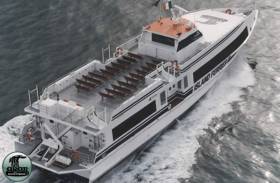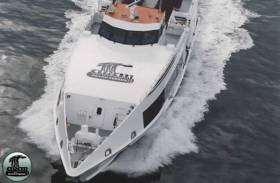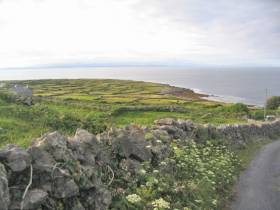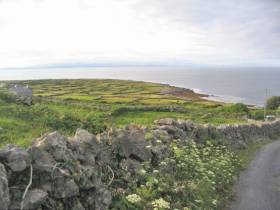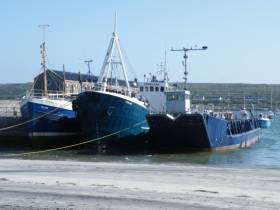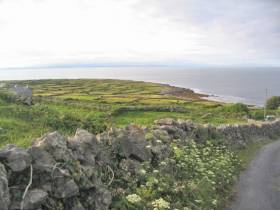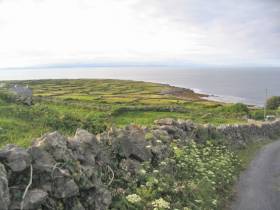Displaying items by tag: Aran Islands
Inis Mór Ferry Operator Makes Deal To Halve Passenger Levy & Resume Winter Service
#AranIslands - The deadlock over Inis Mór’s winter ferry service appears to be over, after the ferry operator agreed to continue absorbing the costs of the council-imposed passenger levy.
According to Galway Bay FM, Island Ferries Teo’s proposal to reduce the levy both retroactively to 2012 and from 2017 onwards has been approved by Galway County Council.
The operator had halted services to the largest of the Aran Islands at the end of November, citing “negative fiscal conditions” that it said were a consequence of the 80c passenger levy.
It’s now emerged that half of the company’s €500,000 debt to the council will be written off, not counting upwards of €450,000 in court costs.
Sailings were restored within days on a temporary basis as talks between the company, Galway County Council and the Department of the Gaeltacht resumed earlier this month.
It’s now expected that winter sailings to and from the island will continue beyond the revised 4 January end date.
Aran Islands Flights Confirmed For Another Four Years
#AranIslands - While Inis Mór’s winter ferry link with the mainland remains in question, Aran Islands residents at least have an answer to their air service woes.
According to Galway Bay FM, Aer Arann Islands has been selected as the State’s preferred tender for the long-running route to the islands in Galway Bay.
The new PSO contract for the islands to Na Minna airport near Rossaveal runs from 1 January 2017 to the end of 2020, confirming continued flights for another four years.
The move follows several extensions to the existing contract that saw the State and Aer Arann at deadlock over costs on the route, as well as a controversial tender in 2015 to replace the decades-old airplane route with a helicopter service.
Meanwhile, an Oireachtas committee was addressed last week by a group representing Inis Mór residents as the dispute over the island’s winter ferry service continues.
Further Talks On Ferry Service to Inis Mór Aran Islands
#AranIslands - Talks are to resume on Friday writes Galway Independent in a bid to ensure the continuation of the ferry service to Inis Mór, Aran Islands.
The Island Ferries service ceased last Wednesday and was due to remain out of action until 17 March next year after the family-run company said it “had been left with no further option but to take such drastic action”.
The service however resumed on Friday evening, following talks between the company, Galway County Council and the Department of the Gaeltacht. The service will now remain in place until 4 January 2017, in “a gesture of goodwill to the Islanders”. This date will be kept under review as discussions continue.
Kevin Kelly, Acting Chief Executive of Galway County Council, said the talks, which centre on passenger levies, are complex but there is a “meaningful engagement process in place”.
“We are working as good as we can to conclude this within the timeframe. It is important that there is progress being made and that all parties feel that the overall approach has the possibility of reaching a successful conclusion.”
Ferry Service to Inis Mór Aran Islands to Resume This Evening While Talks Continue
#AranIslands - Ferry services to Inis Mór, the largest of the Aran Islands will resume this evening, while talks continue to find a long term solution with regard to a year-round service.
The Connacht Tribune writes that Island Ferries, Gaeltacht Minister Sean Kyne and County CEO Kevin Kelly met for talks this morning as Inis Mór residents faced into a second day without a ferry service.
The Island Ferries service ceased on Wednesday, and was due to remain out of action until March.
Last evening, County Councillors gave CEO Kevin Kelly a mandate to meet with Island Ferries on their behalf.
Today’s meeting was also attended by Gaeltacht Minister Sean Kyne and as Afloat previously covered he had called for the Naval Service to provide a short-term service to residents.
In a statement to NewsBreak, Galway County Council has confirmed that Island Ferries, as a gesture of goodwill, will resume its service to Inis Mor from 5 this evening until January 4th.
In the interim, talks will continue in a bid to ensure a year-round service for islanders and visitors.
Operator Pulls Inis Mór Winter Ferry Service
#AranIslands - Ferry services to the mainland from the largest of the Aran Islands will be suspended till March from tomorrow following a last-ditch effort to extend winter sailings.
As previously reported on Afloat.ie, Inis Mór residents were guaranteed their ferry till the end of today (Wednesday 30 November) pending a Galway County Council meeting this week to discuss a long-running dispute over passenger levies.
However, ferry operator Island Ferries Teo has now confirmed to Galway Bay FM that it will withdraw the island's winter service to from tomorrow (Thursday 1 December) till 17 March next year, citing “negative fiscal conditions”.
Aran Islands Ferry Service Extended By Fortnight
#AranIslands - Inis Mór residents have a guaranteed ferry service for two more weeks pending talks over the operator’s planned withdrawal from the island till spring.
Island Ferries Teo confirmed to Galway Bay FM that services from the Galway mainland to the largest of the Aran Islands would continue till Thursday 1 December, two weeks from today (Thursday 17 November).
That’s two days after Galway county councillors are scheduled to discuss the company’s ongoing dispute over passenger levies on 28 November.
As previously reported in Afloat.ie, the ferry operator intends to suspend its “commercially unsustainable” Inis Mór winter service till mid March next year unless the issue of levies is addressed.
Aran Islands Grid Power Restored As Complex Cable Repairs Completed
#AranIslands - Major repairs to an undersea power cable between Galway and the Aran Islands have been completed more than two months after a fault left residents on Inis Meáin and Inis Oírr without power for several days.
According to Galway Bay FM, repairs to the subsea cable were more complex than anticipated, requiring the use of specially trained divers and a diving pod.
However, grid power has now been restored to the islands, which has been using generators transported days after the fault in early August, as previously reported on Afloat.ie.
Inis Mór Ferry Services Suspended Till Spring Over Levy Dispute
#AranIslands - “Policy decisions beyond our control” have been cited by Island Ferries Teo for its suspension of services between the mainland and the largest of the Aran Islands from November till next spring, as Galway Bay FM reports.
The move follows a long-running dispute over a council-imposed passenger levy for the non-PSO ferry route to Inis Mór that’s been subject to sharp fare increases over a number of years.
Earlier this year a deal was reached to extend ferry services to the island that were slated to end in January, after a Supreme Court ruling that forced the company to pay landing charges, according to TheJournal.ie.
However, the company now says it has reached an impasse with the Government and Galway County Council and had been left with no course of action other than to suspend the “commercially unsustainable” winter service.
TheJournal.ie has more on the story HERE.
Aran Islands Cable Repairs Under Way Weeks After Power Outage
#MarineNotice - Repair works are currently ongoing on the Inis Mór–Inis Meáin cable weeks after a fault left the Aran Islands without power for a number of days.
The works, which began last Saturday 10 September and will continue for another week, weather permitting, are being carried out from an offshore platform manoeuvred with the assistance of workboats, as detailed in Marine Notice No 39 of 2016.
The tug ABBE is also operational in the vicinity of the platform during the repairs. Both platform and tug vessel maintain a listening watch on VHF Channels 12 and 16 for the duration of the project.
The platform is displaying day shapes and night lights as required in accordance with the International Regulations for Prevention of Collisions at Sea (COLREGS).
All vessels, particularly those engaged in fishing, are requested to give the area a wide berth and keep a sharp lookout in the relevant areas.
Another recent Marine Notice advises of a programme of maintenance and inspection on the Corrib subsea facilities from this week for the next three week.
Marine Notice No 38 of 2016 says the work will all take place within the 500m Safety Zone and will involve carrying out a programme of maintenance to investigate and repair some of
the subsea facilities as required.
The support vessel Olympic Ares will carry out the maintenance and inspection using a remote operated vehicle or ROV. The vessel will be listening on VHF Channel 16 throughout the project.
Former US Army Landing Craft Transports Generators to Aran Islands
#AranCargoship - The cargsoship that transported generators to restore electricity supply to two of the Aran Islands this week, Afloat has identified as a former US Army landing craft vessel, writes Jehan Ashmore.
The generators were craned off the MV Chateau-Thierry, which among its services, Lasta Mara Teo operates a roll on / roll-off service from Rossaveel, Co. Galway.
As previously reported the subsea cable fault left almost 400 residents of Inis Meáin and Inis Oírr without power for four days, was restored at the beginning of this week. Work, however to repair the subsea cable could take up to four weeks.
The Galway registered twin-screw, Chateau-Thierry operates a Rossaveal-Aran Islands service that is mostly involved in trasnporting large cargoes, maintly trucks, excavators, heavy plant and machinery.
A prime example of moving heavy machinery, were those used in the construction to build the outer harbour of Kilronan (Cill Rónáin) on the main island of Inishmore. This was to improve ferry access to and from the mainland. During construction, vehicles were driven off the Chateau-Thierry, which is equipped with ramps that were lowered onto the beach beside Kilronan Pier.
It was during a visit to Inishmore in June, 2009, that asides observing the busy ferry traffic, trawler Iolair and coaster Stenland were also alongside Kilronan Pier. The former Norwegian vessel that traded as Beth Anja, was then tramping around carrying cargoes along the mid-west coast, between Galway and Westport. It was from the Co. Mayo port was where among the cargoes included building materials loaded for Clare Island.
Also on that Aran occasion, another Norwegian connection was that of the former Hurtigruten coastal cruise cargo-ferry, Midnatsol. The vessel converted to cruiseship, National Geographic Explorer was anchored off Kilronan Harbour. Cruise-goers took to 6,471 tonnes vessel's fleet of zodiacs to reach the island harbour.
As for the works of the new outer pier at Kilronan, this required 77,000 tonnes of large natural stone blocks sourced from Connemara, to protect the breakwater from erosion. The new harbour, twice the area in size of Croke Park, had been voted in 2012 by the public as the Best Engineering Project of the Year.
Also engaged in the project was Irish Dredging, part of the Dutch owned Boskalis Group, which recently completed removal of spoil from Dublin Port and out to dumping grounds in the bay.


























